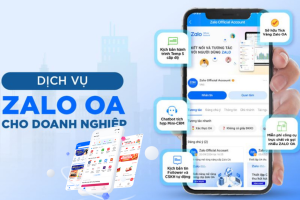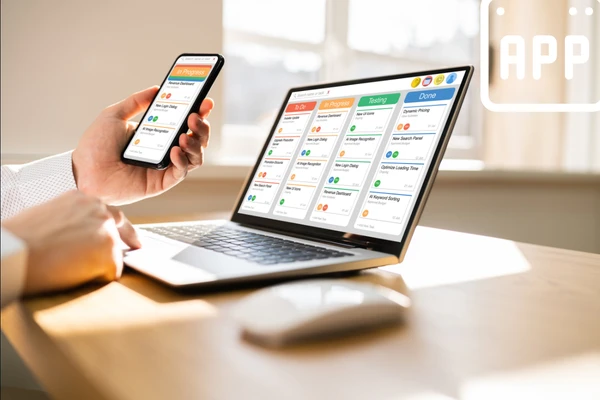How can business email integrate with CRM for customer care?
In the digital transformation era, businesses not only need effective internal communication tools but also need to optimize customer experience. One of the key solutions is integrating business email with a CRM (Customer Relationship Management) system. This combination not only helps synchronize data and save time but also expands the ability to proactively, intelligently, and personally care for customers.
From a tool originally used simply for sending and receiving letters, business email has now become the right arm of CRM systems, creating a continuous connection between customer care, sales, and marketing departments. This article will help you understand the role, benefits, implementation methods, and considerations when integrating business email with CRM software, while also providing step-by-step instructions for effective implementation.

Overview of business email and CRM systems
Business email is not just a basic communication tool but also a component of brand image, professionalism, and security in all electronic interactions of a business. Unlike free email services (Gmail, Yahoo...), this email system is built on the business's own domain, such as nhansu@abcgroup.vn or support@tencongty.com. Using email linked to the business domain creates consistency throughout the communication process, from internal to external.
Outstanding features of business email:
Own domain: Creates a professional impression, helping customers and partners easily identify the organization in each email sent.
Centralized management: The entire system is operated and monitored by the internal IT department or service provider.
Enhanced security: The system integrates security layers such as two-factor authentication (2FA), encryption, IP tracking, and advanced spam filtering.
Flexible authorization: Easily grant different access rights to each department or personnel according to specific functions.
Scalability and integration: Easily expand capacity and connect with job management, storage, CRM, and ERP software.
In an era where customer data is a valuable “digital asset”, using free personal email to exchange work information is a major risk. Business email not only helps protect data but also enhances brand reputation in the eyes of customers.
What is CRM and its role in modern businesses
CRM – short for Customer Relationship Management – is a customer relationship management system that helps businesses establish, maintain, and develop long-term relationships with customers. This is a core tool that helps businesses not only store customer data but also analyze behavior, automate interaction processes, and personalize the experience of each user.
The core benefits of a CRM system include:
Centralized customer data storage: Personal information, transaction history, shopping habits, and interactions are all stored in one place.
Track the entire customer lifecycle: From the potential customer stage to after-sales and long-term care.
Manage the sales pipeline: Helps clearly identify each opportunity, assess conversion rates, and plan appropriate follow-up.
Send email marketing campaigns: Create, manage, and evaluate campaign effectiveness based on specific segmentation lists.
Integrate automatic analytical reports: Measure sales performance, customer service, and assess customer feedback in real-time.
Benefits of integrating business email with CRM systems
Integrating business email with CRM is a strategic step that helps businesses increase work efficiency, optimize customer experience, and build a sustainable customer care foundation. Here are the outstanding benefits that businesses will receive when implementing the integration correctly:
Increase data interconnectivity and standardize customer communication flows
When the business email system is integrated with CRM, the entire content exchanged via email will be automatically attached to the corresponding customer profile. This ensures that each department – from sales and customer care to marketing – can track the entire history of interactions with customers without being dependent on a specific individual.
Real-world example: A sales employee sends a quote to a customer, and the customer responds to request changes to the terms. The customer care department can access the CRM, read the entire previous email chain, and continue to process the request without having to ask from the beginning.
Results:
- No duplication of information or missed requests.
- Shorten the time to process responses.
- Increase seamless experience for customers.
Improve sales efficiency and personalize customer care
A CRM integrated with business email will act like a “smart assistant”, always reminding employees of when to follow-up, alerting them to points of disconnection, or suggesting appropriate care content according to each customer segment.
Support features include:
- Create automatic tasks after each email received from a customer: For example, when a customer sends a request for a quote, the system will automatically create a task for the sales department.
- Remind you to send birthday emails to thank VIP customers.
- Warn customers who have been “silent” for too long, helping the team proactively re-engage.
As a result, businesses not only respond to customer requests but also proactively propose value, increasing retention and repeat purchases.
Reduce risk, increase transparency and control
In a traditional working model, it is common – and risky – for an employee to leave the company with all email exchanges with customers. However, when all emails are managed through the business system and synchronized to CRM, all interactions will be tracked and protected.
Specific benefits:
Managers can view the entire email chain with each customer, thereby assessing the quality of care and professionalism of employees.
Easily transfer customers when there are personnel changes, without interrupting the relationship.
Detect and prevent violations in a timely manner through reporting systems, access logs, and authorization.
Increase the ability to report and analyze customer care data
With a fully integrated system, you not only know how many emails a customer has received, but also know:
- Email open rate by campaign or responsible employee.
- Click-through rate, file downloads, direct responses.
- Average level of interaction by industry or market segment.
- Compare customer care effectiveness between team members.
This information is very valuable in assessing whether the current customer care strategy is effective or needs adjustment. At the same time, it helps the team gradually improve to a more appropriate approach.

Popular CRM platforms that integrate well with business email
In today's business environment, not only is the choice of CRM system important, but the ability to integrate with business email is also a key factor in operational efficiency. Below are popular CRM platforms trusted by global businesses for their superior integration capabilities.
HubSpot CRM – Optimize unlimited customer care
HubSpot CRM is one of the most powerful and easy-to-use free platforms today, outstanding for its seamless integration with most business email systems.
Key features when integrating with business email:
- Detailed email activity tracking: HubSpot CRM records all email opens, link clicks, and customer response times.
- Automatically save emails to customer profiles: No manual copying is required, the entire exchange chain will be linked to each specific customer.
- Send marketing emails right in the CRM: Easy-to-use design interface, allowing you to launch campaigns and measure effectiveness directly.
- Support customer segmentation and content suggestions: Based on data from emails, CRM will suggest suitable content for each audience.
HubSpot is well-suited for small and medium-sized businesses that want to improve customer care quality without investing too much in infrastructure.
Zoho CRM – Flexible, affordable and easy to scale
Zoho CRM is a solution from India but has a global presence, standing out for its diverse features and reasonable cost. This system integrates particularly well with business email platforms such as Zoho Mail, Gmail, and Outlook.
Outstanding advantages when combined with business email:
- Two-way synchronization with major email platforms.
- Tagging by marketing campaign: Automate the care flow based on opening behavior, clicking links, responding...
- Allows you to respond to emails right in the CRM: Customer service staff do not need to switch to a separate email platform.
- Assign rights to each email group: By project, region, or customer segment.
Zoho CRM is an ideal choice for startups and small businesses that want to grow but still need to control costs.
Salesforce – Top choice for large enterprises
Salesforce is the most powerful CRM today, trusted by multinational corporations for its in-depth features and unlimited scalability.
When integrated with business email, Salesforce provides:
- Comprehensive history of email communications: Track response chains, attached files, and response times.
- Connect via add-ons with Gmail, Outlook, Microsoft 365.
- Detailed reports by email, sender, recipient, response rate, and response time.
- AI integration (Einstein Analytics): Analyze emotions and behaviors in email content to predict churn risk or sales opportunities.
However, Salesforce is better suited for large-scale businesses with strong technical teams and complex operational processes.
Microsoft Dynamics 365 – A strong choice for businesses using the Microsoft ecosystem
If your business is using Outlook, Microsoft Teams, or Exchange Server, Dynamics 365 is the most perfectly compatible CRM platform.
Key features when integrating Dynamics 365 with business email:
- Synchronize meeting schedules, emails, calls, and documents in Outlook.
- Create and track customer care emails right in the CRM.
- Intuitive interface, familiar to Microsoft users.
- AI analyzes behavior via email: Suggests follow-up times, assesses customer satisfaction, and detects early signs of risk.
Dynamics 365 is suitable for organizations that already use Microsoft 365 as a seamless digital infrastructure.

Effective ways to integrate business email with CRM
Not every business has an IT team or a large budget to develop a custom integration system. Therefore, here are common ways – from simple to advanced – to easily connect business email with an existing CRM system.
Integration via open API – Flexible, powerful for businesses with technical skills
Most business email and CRM systems today support open APIs. With APIs, businesses can build custom scripts to synchronize bidirectionally between the email system and CRM.
Benefits of API integration:
- Deep customization according to your own workflow.
- Connect multiple systems at the same time: Email – CRM – ERP – chatbot – customer care system...
- Automate advanced processes: For example: When an email contains the keyword “complaint” → Tag it in CRM → Assign the task to the department head.
Requirements: Have a team of programmers or cooperate with a partner specializing in CRM/email implementation.
Install plugins, add-ons directly from email
Popular platforms like Gmail, Outlook, and Zoho Mail... all allow you to install add-ons from CRM to perform quick integration.
Advantages of this method:
- Easy to use: No coding required, just a few clicks.
- Display customer information right next to the email.
- Create new customers from received emails.
- Automatically log emails into customer profiles without manual entry.
Suitable for: Small and medium-sized businesses, startups, or sales teams that want to deploy quickly.
Use automation platforms such as Zapier, Make, Integrately
Zapier and Make are intermediate automation platforms that allow you to connect thousands of applications, including business email and CRM.
Popular workflow example:
When receiving an email from a customer → Create a new contact in CRM.
When tagging an email with “quote” → Create a task in CRM and assign it to a sales employee.
When sending a reply email → Automatically update the status of the sales opportunity to “being processed”.
Advantages:
No programming required.
Intuitive drag-and-drop interface.
Hundreds of integration templates are available for deployment in minutes.
Note: Check the usage package limit if the number of emails and customers is large.

Customer care strategies thanks to integrating business email with CRM
The close connection between business email and CRM systems opens up the ability to optimize the entire customer care process in a modern, personalized, and highly effective way. Here are important strategies to help businesses maximize the power of this integration.
Automate the multi-touchpoint customer care process
Customers today do not just interact through a single channel. They want to be cared for in a unique way, at the right time, and with high personalization. Integrating business email with CRM helps businesses:
Set up automated email chains according to specific stages in the customer journey. For example:
- Early stage: Send welcome emails, thank you notes, and instructions on how to use the product.
- Middle stage: Send usage tips, support documents, renewal reminders, and technical support.
- Final stage: Send renewal offers, satisfaction survey emails, and service reviews.
Automatically personalize content based on behavioral data such as:
- Products purchased, most recent interaction time.
- Geographic location, preferred language.
- Satisfaction level from previous feedback.
Set up behavioral triggers (automation actions):
- If a customer opens an email but does not respond → Send a reminder.
- If a customer clicks on a link → Create a follow-up task for the sales department.
- If there is no interaction after X days → Send a follow-up email or survey the reason.
Attach emails to the comprehensive customer journey
A customer will go through many stages from when they approach to after-sales. Combining CRM and business email helps businesses:
Create a clear customer journey map: CRM identifies each touchpoint that customers interact with via email, call, chatbot, website...
Attach the appropriate type of email according to each stage:
- Awareness: Email introducing the brand, useful documents.
- Consideration: Email comparing features, demo videos, detailed advice.
- Decision: Email offers, quotes, case studies.
- Retention: Support emails, periodic care, loyalty programs.
- Advocacy: Send referral codes, thank you notes, encourage positive feedback.
Ensure interconnectivity between the sales and care departments: Each email sent is saved, helping the next department not have to ask for existing information, thereby increasing the customer experience.
Build a dashboard to measure the effectiveness of email care
Cannot improve without measurement. Integrating email into CRM helps create a real-time dashboard, supporting management and marketing to evaluate the effectiveness of campaigns and care processes:
- Email open – click – response rate: Determine which campaigns are effective, and which email topics are attractive.
- Number of emails sent – average response time: Analyze the proactivity and performance of the care team.
- Satisfaction index (CSAT, NPS): Attach directly to the survey email to evaluate the service.
- Report errors, complaints, and processing: Record and evaluate the quality of support via each email sent.
This dashboard can be exported weekly, monthly, and quarterly to adjust strategies and train the team.

Notes when deploying business email integration with CRM
Although integration brings many benefits, businesses still need to pay attention to a number of technical and operational issues to ensure that the process runs smoothly, securely, and in compliance with the law.
Synchronize the email list accurately and safely
- Always check and compare the email list between the CRM and the contact management system. This helps prevent sending errors, duplicates, or loss of customer data.
- Establish data synchronization standards: Standardize the format (e.g., no spaces, no strange characters in email names).
- Run a test sync on a small group before deploying the entire system.
Comply with anti-spam policies and legal regulations
Email marketing or customer care, if not carefully controlled, can easily violate the law and adversely affect the brand.
Comply with international policies such as:
- CAN-SPAM Act (USA)
- GDPR (Europe)
- Network Information Security Law in Vietnam
- Use authenticated business emails:
- Set up SPF, DKIM, and DMARC correctly to ensure that emails are not marked as spam.
- Clearly state the sender, the reason for receiving the email, and how to unsubscribe in the body of the letter.
Avoid sending mass emails without segmentation: Always break the list down by audience to increase open rates and avoid having your sending IP blocked.
Strict security and access authorization
When integrating business email into CRM, you are attaching all customer communications to a single system. This requires:
- Detailed authorization: Who can view, who can edit, who can send care emails...
- Enable two-factor authentication (2FA): Protect employee accounts from unauthorized access.
- Track access logs: Record user behavior and retrieve data when needed.
Periodic checks: Scan for security vulnerabilities and update system versions continuously.
Integrating business email with CRM: Strategic move for the digital future
In the context of rapid digital transformation, customers are increasingly expecting a seamless, professional, and personalized experience. Integrating business email with a CRM system not only helps businesses improve customer care efficiency but also creates a foundation to operate the entire sales – after-sales – feedback process effectively.
From an operational perspective, this is not simply a connection between two tools, but a focused data strategy that helps:
- Capture the entire customer journey.
- Synchronization between departments: Marketing – Sales – Customer Service.
- Personalize communication and measure effectiveness with real data.
Whether you are a start-up business or a large organization that wants to optimize processes, applying this integration will help improve service quality, reduce operational errors, and increase customer satisfaction – a vital factor in today's competitive environment.
Contact information:
- MIMA Trading and Service Company Limited
- GPDKKD: 0318672839 issued by Ho Chi Minh City Department of Planning and Investment on September 17, 2024
- Address: 31/3B Ap Thoi Tu 1, Dong Thanh Commune, Ho Chi Minh City, Vietnam
- Phone: 0909 035 333
- Website: https://mimadigi.com
- Email: info@mimadigi.com


























Share your review